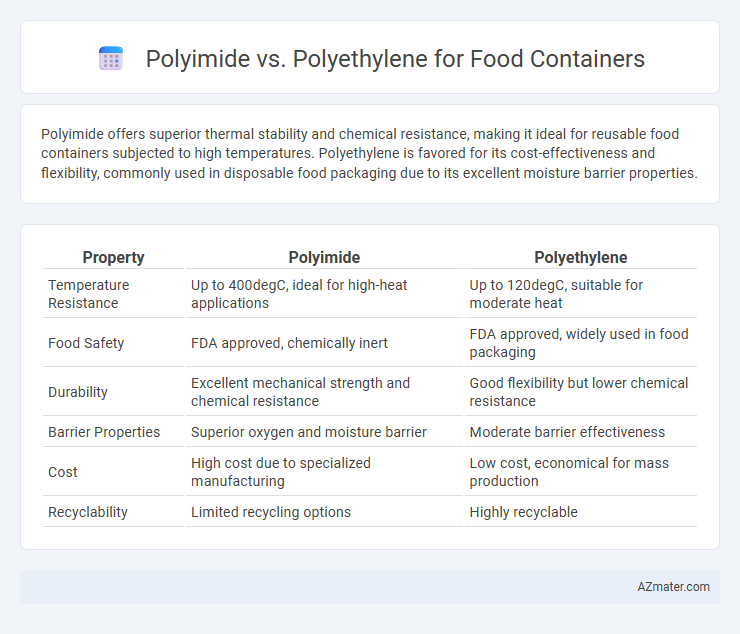Polyimide offers superior thermal stability and chemical resistance, making it ideal for reusable food containers subjected to high temperatures. Polyethylene is favored for its cost-effectiveness and flexibility, commonly used in disposable food packaging due to its excellent moisture barrier properties.
Table of Comparison
| Property | Polyimide | Polyethylene |
|---|---|---|
| Temperature Resistance | Up to 400degC, ideal for high-heat applications | Up to 120degC, suitable for moderate heat |
| Food Safety | FDA approved, chemically inert | FDA approved, widely used in food packaging |
| Durability | Excellent mechanical strength and chemical resistance | Good flexibility but lower chemical resistance |
| Barrier Properties | Superior oxygen and moisture barrier | Moderate barrier effectiveness |
| Cost | High cost due to specialized manufacturing | Low cost, economical for mass production |
| Recyclability | Limited recycling options | Highly recyclable |
Introduction to Polyimide and Polyethylene
Polyimide is a high-performance polymer known for its exceptional thermal stability, chemical resistance, and mechanical strength, making it suitable for advanced food container applications requiring durability under extreme conditions. Polyethylene, a widely used thermoplastic, offers excellent flexibility, moisture resistance, and food safety compliance, commonly utilized for everyday disposable and reusable food packaging. Selecting between polyimide and polyethylene depends on specific requirements such as temperature tolerance, chemical exposure, and cost-effectiveness in food container design.
Material Properties Overview
Polyimide offers exceptional thermal stability and chemical resistance, making it suitable for high-temperature food storage and sterilization processes, while polyethylene provides excellent flexibility, moisture resistance, and is food-safe for cold or ambient temperature applications. Polyimide's high tensile strength and dimensional stability contrast with polyethylene's impact resistance and cost-effectiveness, influencing their respective uses in durable versus disposable food containers. The selection depends on the required temperature range, exposure to chemicals, and mechanical stress during the container's lifecycle.
Safety and Food Contact Compliance
Polyimide offers superior thermal stability and chemical resistance, making it highly safe for repeated food contact and compliant with FDA and EU food safety regulations. Polyethylene, commonly used in food containers, provides excellent food contact compliance due to its inert nature but has lower heat resistance and may degrade under high-temperature conditions. When prioritizing safety and regulatory adherence, polyimide containers are preferred for high-heat applications, while polyethylene remains suitable for everyday use with moderate temperature exposure.
Thermal Resistance Comparison
Polyimide exhibits superior thermal resistance compared to polyethylene, withstanding continuous use temperatures up to 260degC, whereas polyethylene typically degrades above 80-130degC depending on its density. This high thermal stability makes polyimide ideal for applications requiring sterilization or microwave heating without deformation or toxic leaching. In contrast, polyethylene's lower melting point limits its use to low-temperature food storage and prevents exposure to high heat during cooking processes.
Chemical Resistance and Reactivity
Polyimide exhibits superior chemical resistance and low reactivity compared to polyethylene, making it ideal for food containers exposed to aggressive solvents or high temperatures. Polyethylene can be susceptible to degradation when in contact with oils, fats, and certain acids, which may impact food safety and container integrity. Polyimide's robust molecular structure ensures long-term stability and reduced risk of chemical leaching in various food storage applications.
Durability and Longevity
Polyimide exhibits exceptional durability and longevity in food containers due to its high thermal stability, chemical resistance, and resistance to mechanical wear, making it suitable for repeated use and harsh conditions. Polyethylene, while cost-effective and flexible, tends to degrade faster under high temperatures and prolonged exposure to certain chemicals, limiting its lifespan in demanding food storage scenarios. The superior molecular structure of polyimide ensures sustained performance without deformation or leaching, enhancing food safety and container lifespan.
Flexibility and Structural Performance
Polyimide exhibits superior flexibility and thermal stability compared to polyethylene, making it ideal for high-temperature food container applications where durability is critical. Polyethylene offers excellent impact resistance and affordability but lacks the structural rigidity and heat resistance of polyimide, limiting its use in more demanding environments. The choice between polyimide and polyethylene hinges on balancing the need for heat tolerance and mechanical strength against cost and flexibility.
Environmental Impact and Recyclability
Polyimide offers exceptional thermal stability and chemical resistance but poses significant challenges in recycling due to its complex polymer structure, often requiring specialized facilities that are scarce and costly. Polyethylene, widely used in food containers, is highly recyclable through established municipal systems, contributing to lower environmental impact when managed properly, though it may release microplastics during degradation. Assessing environmental impact favors polyethylene for its easier recyclability and broader infrastructure support, while polyimide's durability limits its lifecycle sustainability in food packaging.
Cost Considerations for Manufacturers
Polyethylene offers cost advantages over polyimide due to its lower raw material prices and simpler processing requirements, making it more attractive for high-volume food container production. Polyimide, while providing superior thermal stability and chemical resistance, involves higher production and material costs, which may limit its use to specialized or premium food packaging applications. Manufacturers must balance the cost-efficiency of polyethylene with the performance benefits of polyimide when selecting materials for food containers.
Best Application Scenarios: Polyimide vs Polyethylene
Polyimide excels in high-temperature food container applications due to its exceptional thermal stability and chemical resistance, making it ideal for microwaveable or oven-safe dishes. Polyethylene offers superior flexibility, moisture resistance, and cost-effectiveness, which suits it for disposable or refrigerator storage containers. For scenarios requiring repeated use and exposure to heat, polyimide is preferred, whereas polyethylene is better suited for low-cost, everyday food storage solutions.

Infographic: Polyimide vs Polyethylene for Food Container
 azmater.com
azmater.com